
New Deal Photographer Sets His Eye on La Crosse
(written by Sarah Ludington, Archives staff)
In the summer of 1939, photographer Arthur Rothstein traveled through the Midwest to document rural life. Employed by a special program within the U.S. Farm Security Administration called the Historical Section of the Information Division, his assignment took him from Chicago to North Dakota and Montana that summer. Along the way, Rothstein traveled through La Crosse, capturing poignant moments of a city in the midst of change.
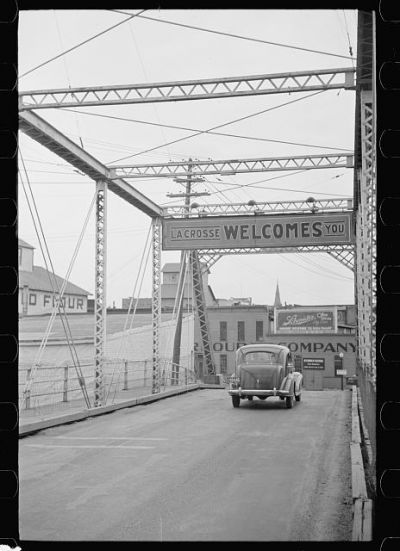
The view of La Crosse to visitors from the west is framed in steel girders as a sign welcomes them to the city. This was the last summer the sign would do so; the new bridge opened only a few months after this moment was captured. Photo by Arthur Rothstein, Library of Congress, Prints & Photographs Division, Farm Security Administration/Office of War Information Black-and-White Negatives.
A part of Franklin D. Roosevelt’s New Deal plan, the Farm Security Administration (FSA) was first simply called the Resettlement Agency (RA), and later the photo unit merged with the Office of War Information (OWI). The goal of the administration was to support and, in some cases, relocate impoverished farmers and families during the Great Depression. The photography unit was a small part of this, but would have a great impact. Headed by Roy Stryker, Rothstein’s professor at Columbia, a team of photographers traveled throughout rural America documenting what they saw. You may be familiar with the most famous of these photographs, titled Migrant Mother and taken by Dorothea Lange, which depicts a woman, hand lightly brushing her chin in a pensive moment, surrounded by two of her children.

A photo of the photographer; Rothstein examines a camera lens in 1938. The hole punch in the image meant that the negative was originally “killed” from the series; a print wouldn’t be made of it. Library of Congress, Prints & Photographs Division, Farm Security Administration/Office of War Information Black-and-White Negatives.
Arthur Rothstein was the first photographer hired. Born in 1915 in Manhattan and raised in the Bronx in New York City, Rothstein attended Columbia University and became interested in photography, even founding a camera club there. Having already worked on a project with his professors documenting agriculture in America, upon graduation in 1935 he was a natural choice for work in the new photo unit. His largest assignment with the photo unit came in 1937 when he documented a town called Gee’s Bend in Alabama. Later in his career, he worked for Look and Parade magazines, and was faculty at the Graduate School of Journalism of his alma mater, Columbia University. But in 1939, he brought his photographer’s eye through La Crosse.
It is unclear how Rothstein traveled from Chicago to La Crosse; the shots he took of the Burlington Zephyr and the small area of the city that he stuck to when photographing make it seem that he perhaps traveled by train and had a little time to pass before continuing his travels. All the images that are identifiable as La Crosse are clustered around the area of the river bank and the wagon bridge. However he came to be in La Crosse, it is apparent that he was inspired by what he saw here.
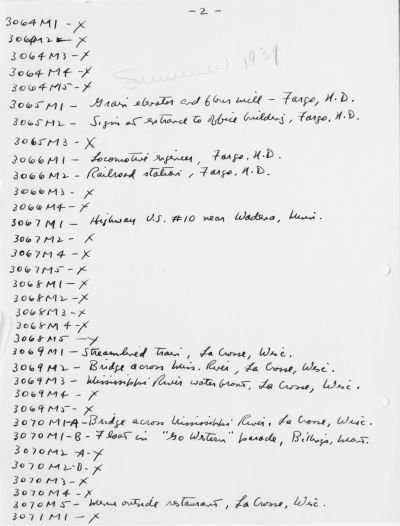
Arthur Rothstein’s handwritten captions give a rough idea of his itinerary in Summer 1939. Like the hole punch in the negatives, the “X” denotes a photo that was not intended to be printed. Library of Congress, Prints & Photographs Division, Written records in the Farm Security Administration / Office of War Information Collection.
While many of the assignments given to the photographers asked them to meet families and capture their everyday lives, the photos taken in La Crosse capture the city itself. His eye was drawn to moments that, unbeknownst to him, show a transition happening. Later that summer, a brand new, state-of-the-art bridge would open and a remnant of the old days, the wagon bridge, would close. Through New Deal programs, many roads and infrastructures were updated. Business-owners and home-owners were modernizing their spaces. The photos show views of both the old and new bridges across the Mississippi River; an out of use rail car near a riverfront railroad spur; a glimpse of a very industrial-looking riverfront; and the shiny, new Burlington Zephyr train set against a backdrop of nineteenth century styled brick buildings. People rarely figure into these shots.
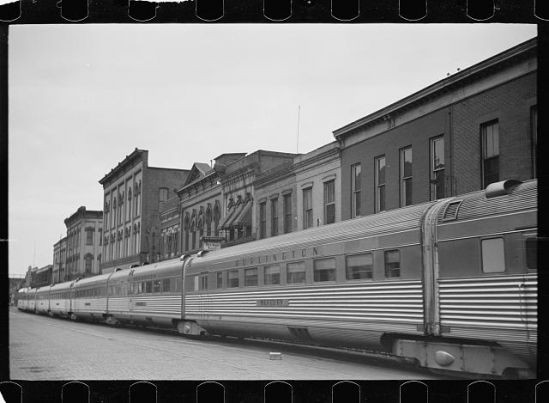
The sleek, uniform passenger cars of the Burlington Zephyr contrast with the older, eclectic skyline on Second Street looking northeast. Library of Congress, Prints & Photographs Division, Farm Security Administration/Office of War Information Black-and-White Negatives.

A view of the Interstate Bridge, close to being finished, framed by the old wagon bridge taken from the east bank of the Mississippi River which is now part of Riverside Park. Library of Congress, Prints & Photographs Division, Farm Security Administration/Office of War Information Black-and-White Negatives.

A view taken near the rails running behind buildings along Front St. shows a railcar awaiting use. Library of Congress, Prints & Photographs Division, Farm Security Administration/Office of War Information Black-and-White Negatives.
The photo collection of the FSA/OWI, when it was transferred to the Library of Congress in 1944, amounted to about 175,000 negatives in total. Only about 70,000 of these were printed; less than 50%. The photos were heavily used in publications to show the impact of the Great Depression. Follow-up trips also occurred to provide a “before and after” of the aid that the FSA provided. There were critics of the program in Congress who viewed the project as propaganda. In 1943, after becoming part of the Office of War Information, the program lost its funding. Recognizing the need to preserve the photos, Roy Stryker moved quickly to bring the collection to the Library of Congress.
While the Library of Congress made the prints accessible to researchers since the 1940s, the over 100,000 negatives remained unseen, kept in stable storage until they were digitized and made available on the Library of Congress’s website in the late 1990s-early 2000s. A good portion of the photos of La Crosse were among those that were never printed.
You may have seen some of these images shared here and there via social media. Because the program was a federally funded project, the photographs themselves have always been in the public domain. At the time of the project, that made them easy for publications to freely publish and now that they are digitized and available to use it is possible to reproduce them in many places.
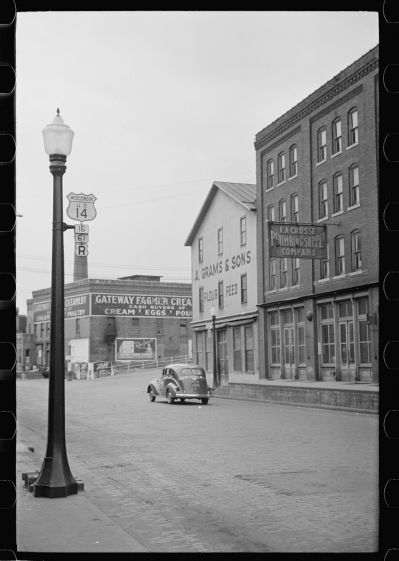
Rothstein captured the intersection of Front and Mt. Vernon Streets; the approach of the old wagon bridge across the Mississippi River. Just a few months after this photo was taken, this bridge would close and be dismantled; the new one would open in September 1939. Library of Congress, Prints & Photographs Division, Farm Security Administration/Office of War Information Black-and-White Negatives.
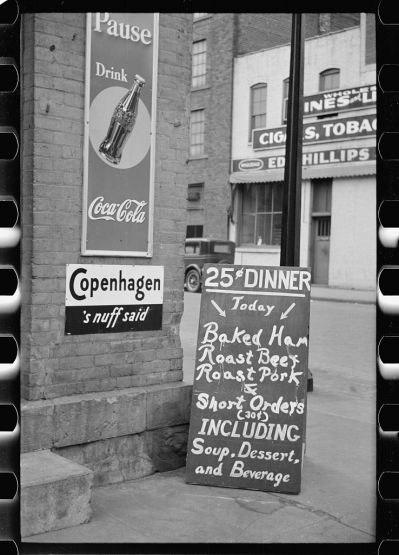
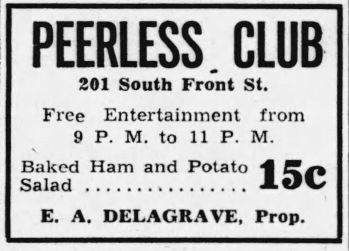
This menu board advertising dinner for 25 cents, stood outside of 201 S. Front St.; the location of Edward Delagrave’s tavern. Delagrave had helped open Del’s Tavern with his brother, Louis, in 1932 but would leave the partnership in 1939. Library of Congress, Prints & Photographs Division, Farm Security Administration/Office of War Information Black-and-White Negatives. Advertisement printed in the La Crosse Tribune, August 19, 1939.
You can view more photos of La Crosse or search for more at the Library of Congress’s Prints & Photographs Online Reading Room.
